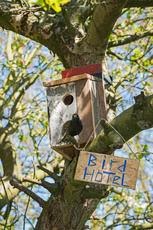 |
| Short eared Owl - Tim Melling |
Ever wanted to experience one of the best wildlife
spectacles in the region? December is the perfect month to do just that, as
the RSPB invites people to enjoy a date with nature at Parkgate.
Many local people are familiar with the phenomenon of the
high spring tides flooding the vast saltmarsh of the Dee Estuary, but
few have been there to witness it and the wildlife spectacle that
follows. Now, the
team at RSPB Dee Estuary nature reserve is holding free
events next week in a bid for people to see this amazing sight for
themselves.
The Dee s saltmarsh is home to hundreds of small mammals,
such as short-tailed field voles, which attract magnificent birds
of prey including short-eared owls and hen harriers. As the
incoming tide floods the marsh, the voles are flushed from their homes
and move ever closer to the promenade, resulting in a feeding frenzy
amongst the owls, harriers and resident kestrels.
John Langley, RSPB Information Assistant, said: It was only a month ago that I first experienced the tide touching the wall
at Parkgate hard to believe it s possible considering how distant the
water is on a
normal day.
It's a little sad
to see the voles desperately fleeing for their lives. I ve heard tales of them scrambling up the sea
wall and running around people s feet, but it s a great reminder of how
much wildlife is thriving on the marsh and the value of the RSPB
protecting such a vast wilderness. If you re patient and you know where to look,
you can usually see the birds of prey flying over the marsh, but
a high tide pushes everything closer, giving even better views and
more chance of exciting action.
Thousands of
birds geese, ducks and waders are trying to keep on the edge of the water, so large flocks can be seen
shifting around trying to find drier ground. Other predators take
advantage too foxes
will be more than happy to snatch an easy meal, whilst
even herons and gulls have been seen helping themselves to voles and
small birds.
The extent of the
spectacle is dependent on the weather conditions on the day low
pressure and a strong northwesterly wind are the best to drive the tide in fully, but at this time of year the
chances of that are quite good. Obviously that s something we won t know
until closer to the time but we ll keep our fingers crossed and be
present at Parkgate regardless, so hope people will come and join
us.
To give people the best chance of experiencing this rare
spectacle, the RSPB will be hosting events on Parkgate promenade on the
three days of upcoming high tides; Wednesday 4, Thursday 5 and Friday 6
December. These are free of charge and there will be telescopes and
binoculars for public use.
 |
| Kestel with prey at Parkgate |
The events are part of the Wild Wirral Date with Nature which is showcasing the outstanding wildlife of the Wirral
Peninsular and its coastline through a series of events supported by Wirral
Borough Council this winter. Full details and dates of further
events can be found on the RSPB website
For more information on the Dee Estuary reserve and its
activities, please call the reserve on 0151 353 8478, or visit the
website




















